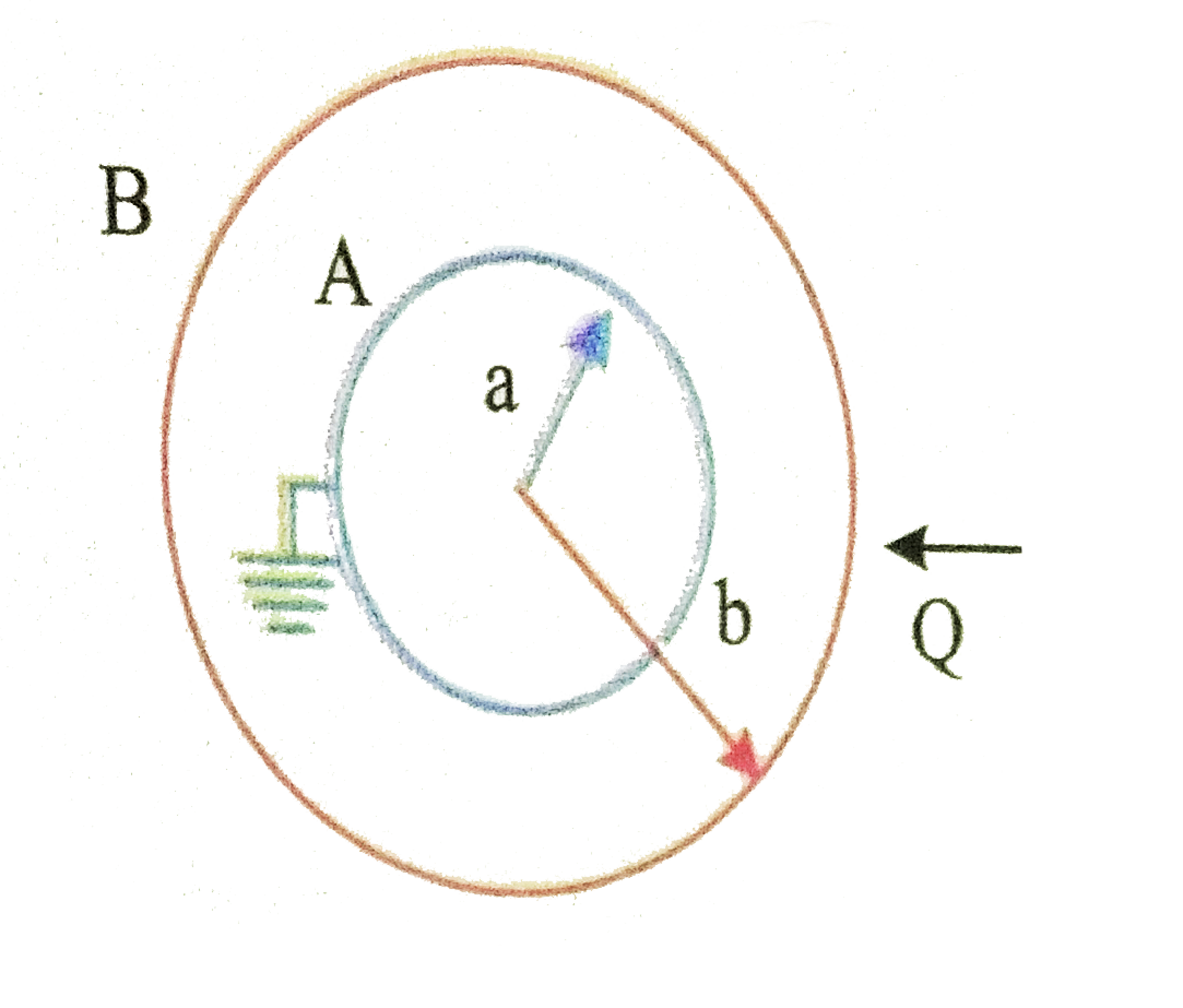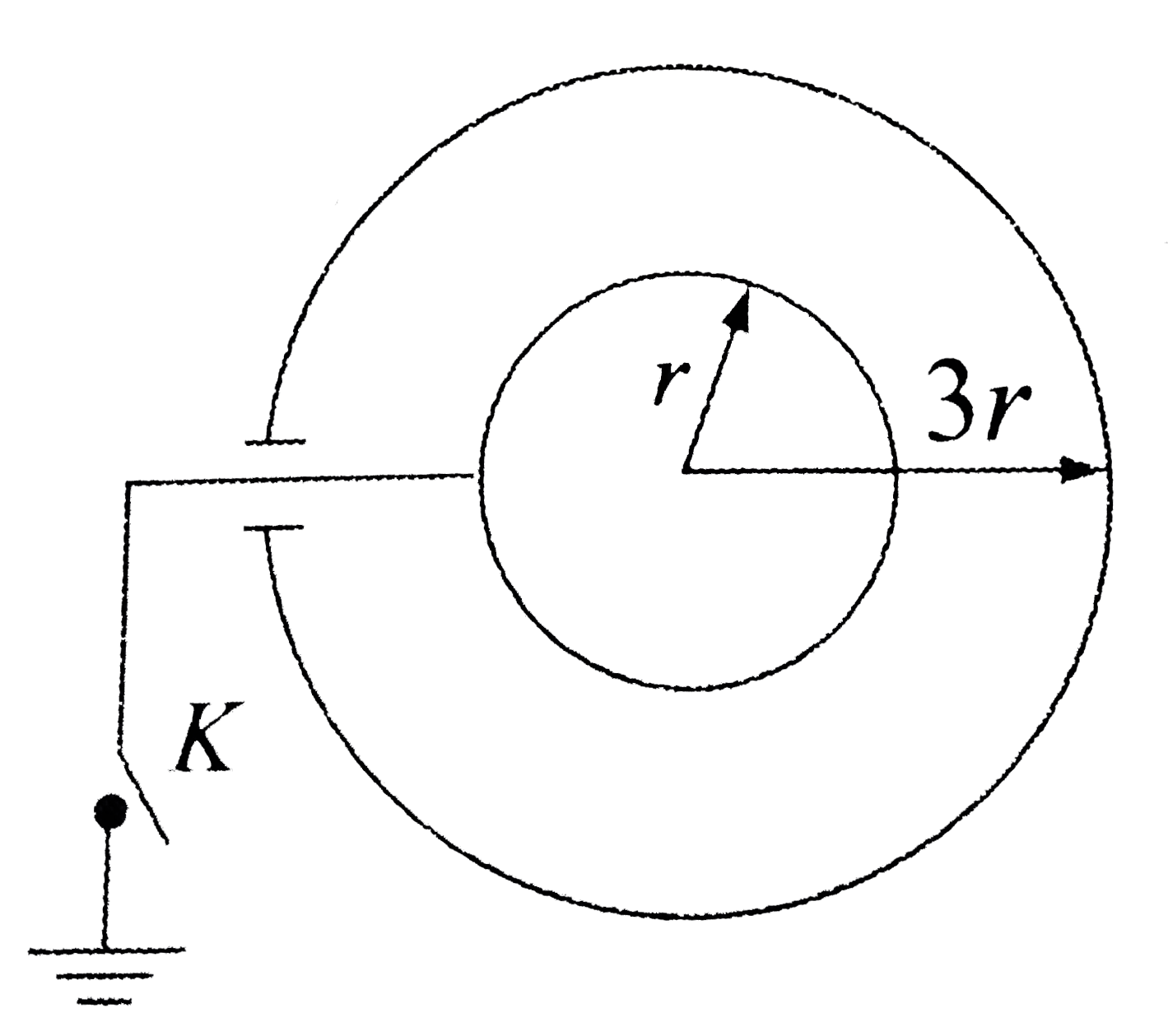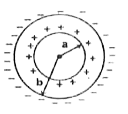there are two concentric metallic shells of radii R and 2R, if outer shell is given charge q1 , then charge on surface of inner shell will be
−q12
−q1
q12
zero
To solve the problem of finding the charge on the surface of the inner shell when the outer shell is given a charge q1, we can follow these steps:
1. Understand the Setup: We have two concentric metallic shells. The inner shell has a radius R and the outer shell has a radius 2R. The outer shell is given a charge q1.
2. Apply Gauss's Law: According to Gauss's Law, the electric field inside a conductor in electrostatic equilibrium is zero. This means that if we consider a Gaussian surface that lies between the two shells (i.e., at a radius greater than R but less than 2R), the electric field E in this region must be zero.
3. Calculate the Enclosed Charge: Gauss's Law states that the electric flux through a closed surface is proportional to the charge enclosed by that surface. Mathematically, it is given by:
ΦE=∮E⋅dA=Qenclosedϵ0
Since the electric field E is zero in the region between the two shells, the left-hand side of the equation becomes zero:
0=Qenclosedϵ0
This implies that the enclosed charge Qenclosed must also be zero.
4. Determine the Charge on the Inner Shell: The charge on the inner shell must be such that the total enclosed charge is zero. Since the outer shell has a charge q1, the inner shell must have a charge of −q1 to ensure that the total charge within the Gaussian surface is zero. However, since the inner shell is a conductor and is not influenced by the outer shell's charge, it will redistribute its charge such that the net charge on the inner shell remains zero.
5. Conclusion: Therefore, the charge on the surface of the inner shell is:
Charge on inner shell=0
Final Answer:
The charge on the surface of the inner shell is 0.
ΦE=∮E⋅dA=Qenclosedϵ0
Since the electric field E is zero in the region between the two shells, the left-hand side of the equation becomes zero:
0=Qenclosedϵ0
This implies that the enclosed charge Qenclosed must also be zero.
Charge on inner shell=0
The charge on the surface of the inner shell is 0.
Topper's Solved these Questions
- TEST 1BOOK - AAKASH INSTITUTE ENGLISHCHAPTER - TEST 1EXERCISE - EXERCISE
21 Videos
- SYSTEM OF PARTICLES AND ROTATIONAL MOTIONBOOK - AAKASH INSTITUTE ENGLISHCHAPTER - SYSTEM OF PARTICLES AND ROTATIONAL MOTIONEXERCISE - Try Yourself
63 Videos
- TEST 2BOOK - AAKASH INSTITUTE ENGLISHCHAPTER - TEST 2EXERCISE - Exercise
308 Videos
Similar Questions
Consider two concentric metalic shell's of radii R and 2R. The inner shell is having charge Q and outer shell is uncharged. If they are connected with a conducting wire. Then,
View SolutionThere are two concentric metal shells of radii r1 and r2(>r1). If initially, the outer shell has a charge q and the inner shell is having zero charge and then inner shell is grounded. Find :
(i) Charge on the inner surface of outer shell.
(ii) Final charges on each sphere.
(iii) Charge flown through wire in the ground.
View SolutionThere are two concentric conducting spherical shells of radii 10cm and 20cm. The outer shell is charged to a potential of 50esu while inner shell is earthed. The charge on outer shell is
View SolutionConsider two concentric spherical metal shells of radii 'a' and b>a .The outer shell has charge Q but the inner shell has no charge.Now the inner shell is grounded ,This means that the inner shell will come at zero potential and that electric fields lines leave the outer shell and end on the inner shell.(a) Find the charge on the inner shell
Find the potential on outer sphere.

View SolutionTwo concentric conducting shells of radii R and 2R are having charges Q and -2Q respectively.In a region r
View SolutionFigure shows two conducting thin concentric shells of radii r and 3r. The outer shell carries charge q and the inner shell is neutral . The amount of charge that flows from the inner shell to the earth after the key K is closed is equal to (1/n)th of the charge on the outer shell. What is the value of n ?
 .
.
View SolutionThere are two concentric conducting spherical shells of radius rA and rB respectively (rB=2rA). If the inner shell is given a charge Q and outer shell is given a charge 2Q, then the potential difference between the surfaces of the shells will be K=14πε0
View SolutionThere are two concentric spherical shells with inner shell having positive charge q and outer shell having a charge -q. Now outer shell is supplied a charge -2q and inner shell is earthed, Calculate the ratio of initial and final capacities of the system. (If a = 3R, b= 5R)

View SolutionConsider two concentric spherical metal shells of radii r1 and r2(r2>r1). If the outer shell has a charge q and the inner one is grounded, then the charge on the inner shell is
View SolutionThere are two concentric hollow conducting spherical shells of radii r and R(R>r). The charge on the outer shell is Q. What charge should be given to the inner shell, so that the potential at a point P , at a distance 2R from the common centre is zero ?
View Solution
